Notes: The construction of a railway north from Birmingham Snow Hill to Priestfield, where it would meet the Oxford, Worcester & Wolverhampton Railway (OW&WR) was authorised on 3 August 1846 to the Birmingham, Wolverhampton & Dudley Railway (BW&DR). The BW&DR favoured leasing the line to the Great Western Railway (GWR) from the outset as it planned the line to be constructed to the GWR’s broad gauge (7ft 0¼in) rather than what was, increasingly, the standard gauge (4ft 8½in). Negotiations with the GWR in regard to leasing and running the line started on 12 November 1846, only months after the railway company had been incorporated, and by Act of Parliament of 31 August 1848 the BW&DR was purchased by the GWR prior to any construction taking place. Construction of the line was started by the GWR during 1851 and by June 1852 the original Act was due to lapse and the GWR successfully applied to Parliament for a 3½-year extension to the original Act. The GWR had attempted not to construct the line at all preferring to negotiate with the London & North Western Railway (LNWR) to gain running rights along the Stour Valley line; negotiations failed as the, ever suspicious, LNWR was attempting to delay the GWR reaching its ultimate goal, Liverpool.
Construction was complete by the summer of 1854 and the line was duly inspected by Captain Sir Douglas Strutt-Galton in August. It is not recorded whether or not the inspection was a success, but, the following day a tubular bridge over the turnpike road at Winson Green collapsed following the passage of a contractor’s locomotive working a ballast train. Isambard Kingdom Brunel visited the line the following day and a thorough inspection of the bridges along the route with John Mc Clean, the resident engineer, resulted in five of them being condemned. The opening of the line had been set for 1 September 1854 but this was now unachievable as remedial work on the structures was to take some months. Following the strengthening of the five bridges the line was again inspected and passed fit for traffic, opening on 14 November 1854.
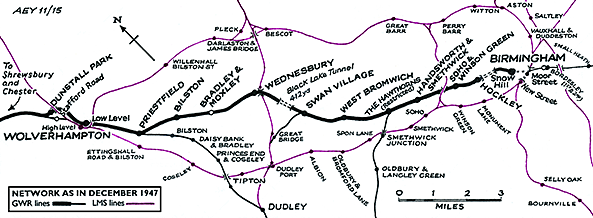
The station opened as Handsworth on 14 November 1854 as a two platform affair with the main buildings situated on the up (Birmingham) direction platform and a small range of buildings on the down platform: a covered GWR footbridge connected the two. Access to the station was provided from Booth Street via a short, un-named driveway which led to a small forecourt. Goods facilities were provided with a two road covered shed located directly south-west of the down platform with the Birmingham Railway & Carriage Works (BRC&W) being established, to the north-east, in the same year. The main building and accommodation were located on the Birmingham-bound (up) platform. Its design, seen also at Bilston Central, Wednesbury Central and West Bromwich stations, was in an austere Classical style, imposing and highly distinctive. The style is not unlike some of those by the noted railway architect Francis Thompson, such as Holywell Junction, but it seems unlikely that he had any direct influence on Bilston and its neighbours. A two-storey central block 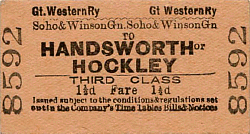 rose above single-storey wings. The particular, somewhat dour, character of the building was given by the parapet (or blocking course) on the front and rear single-storey elevations and a cornice on the central section, almost concealing hipped roofs that lay behind them – a style associated with terraces with Classical pretensions in London, Bristol and Cheltenham. Although the overall construction was of brick, stone pilasters contributed gravitas to the upper storey of the central block, and stone was also employed in the cornices, parapets, quoins and the string course that surrounded the building. The openings on the upper floor and on the forecourt elevation of the wings were rectangular, with tablets below them bearing a simple geometric pattern; the central section of this elevation and all ground floor openings on the platform side were broad segmental arches apart from one centrally placed rectangular window. The arched openings were given stone quoins in a radial layout which added the only cheerful note to the otherwise sombre design. At the north-west end of the building was a short, single-storey extension with a lower roof-line than the adjoining wing repeating its style, even to the inclusion of a parapet. A ridged awning stretched along the platform elevation of the building. rose above single-storey wings. The particular, somewhat dour, character of the building was given by the parapet (or blocking course) on the front and rear single-storey elevations and a cornice on the central section, almost concealing hipped roofs that lay behind them – a style associated with terraces with Classical pretensions in London, Bristol and Cheltenham. Although the overall construction was of brick, stone pilasters contributed gravitas to the upper storey of the central block, and stone was also employed in the cornices, parapets, quoins and the string course that surrounded the building. The openings on the upper floor and on the forecourt elevation of the wings were rectangular, with tablets below them bearing a simple geometric pattern; the central section of this elevation and all ground floor openings on the platform side were broad segmental arches apart from one centrally placed rectangular window. The arched openings were given stone quoins in a radial layout which added the only cheerful note to the otherwise sombre design. At the north-west end of the building was a short, single-storey extension with a lower roof-line than the adjoining wing repeating its style, even to the inclusion of a parapet. A ridged awning stretched along the platform elevation of the building.
Upon opening the station was known as simply Handsworth with the suffix’ Smethwick’ being added by the 1890s. Interestingly the Bradshaw’s December 1895 timetable has the station listed on three separate timetables, London Paddington to Birkenhead Woodside, Birmingham Snow Hill to Dudley and Birmingham Snow Hill to Stourbridge: the suffix of Smethwick is used on the Birkenhead timetables whereas on the Stourbridge and Dudley tables it does not appear.
The line was converted to standard gauge during prior to 1 April 1869.
During the early part of the twentieth century the GWR realised that capacity limitations between Snow Hill and Handsworth Junction had to be addressed and, following the rebuilding of Snow Hill station, set about quadrupling the running lines from Hockley through to Handsworth Junction. The main up and down passenger lines were grouped together to the north with, what became known as, the ‘relief up and down’ lines to the south. The station was partially re-built to provide platform 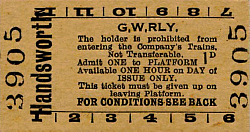 faces for the new relief lines. The original Birmingham platform remained although it was extended in the Birmingham direction up to Booth Street. A central island platform was created, on the site of the Wolverhampton platform with one face serving the down main whilst the other served the up relief line. A further platform was constructed, south-west of the island, to form the down relief platform. The sidings of the goods yard were slewed to the south to allow the platforms to be effectively shoehorned in without the company having to purchase any additional land, although the conversion from broad to standard gauge must have certainly helped with the project. A new covered footbridge was constructed to serve all three platforms. A barrow crossing, at the Wolverhampton end, was constructed to allow parcels and other such items to be transferred conveniently between the platforms. The four-track section opened on 19 December 1909. faces for the new relief lines. The original Birmingham platform remained although it was extended in the Birmingham direction up to Booth Street. A central island platform was created, on the site of the Wolverhampton platform with one face serving the down main whilst the other served the up relief line. A further platform was constructed, south-west of the island, to form the down relief platform. The sidings of the goods yard were slewed to the south to allow the platforms to be effectively shoehorned in without the company having to purchase any additional land, although the conversion from broad to standard gauge must have certainly helped with the project. A new covered footbridge was constructed to serve all three platforms. A barrow crossing, at the Wolverhampton end, was constructed to allow parcels and other such items to be transferred conveniently between the platforms. The four-track section opened on 19 December 1909.
The First World War saw services reduced on the network as a whole to facilitate the operation of extra troop and ammunition trains and release railwaymen into the armed forces. During the conflict the BRC&W works were busy constructing Ambulance Trains (as they had during the Second Boer War in 1899), Handley Page designed bombers and Geoffrey de Havilland-designed Airco DH10s all of which moved south by rail. The cessation of the conflict saw services slowly return to their pre-war levels.
Bradshaw's December 1895 to see a larger version click here
Analysis of Bradshaw’s December 1895 timetable gives a good indication of the pre-World War One service levels. In the down direction (Wolverhampton, Dudley & Stourbridge) 50 services ran on weekdays from 5.52am through to 11.37pm with 19 on Sunday. In the up direction there was a very similar pattern with 50 weekday workings from 7.04am to 11.45pm and 20 on Sunday. The post-World War One Bradshaw’s of July 1922 shows that the service levels had improved on weekdays to, 56 down direction services from 5.45am to 11.27pm on Monday-to-Friday with an extra three on Saturday. In the up direction 59 departures were seen on weekdays (Monday-to-Saturday) from 5.51am through to 11.10pm. The 11.10pm service is worthy of note being one of only two through workings to London Paddington; this late night service arrived in the capital at 3.30am the following morning. Due to the withdrawal of the Swan Village to Dudley Sunday service during World War One, which became permanent following the cessation of the conflict, the Sunday service levels saw a dip in comparison to the 1895 time table with 15 in each direction.
At the time of the ‘Big Four’ Grouping of 1 January 1923 Handsworth & Smethwick remained under the control of the GWR.
The Second World War, again, brought service reductions and an increase in freight and troop movements with the local BRC&W factory focusing on the war effort. During World War 2, the factory had a major impact on tank production as one the many companies building tanks: the A10 Cruiser, Valentine, Churchill, Cromwell and Challenger. They led the design and production of the Cromwell tank in liaison with Rolls Royce and Rover on the Meteor engine. The company also built Hamilcar gliders in 1939-1945. The Birmingham Blitz of 1941 saw the goods shed take a direct hit in the early hours of 12 December, with extensive damage sustained; any damage to the station was not recorded. Although run down at the end of the conflict, the GWR started to reintroduce services which had been curtailed for the duration of the war. Change, though, was on the horizon.
On 1 January 1948 the railways were nationalised and Handsworth & Smethwick came under the control of British Railways (BR) Western Region (WR).
During the London Midland Region’s (LMR) electrification programme of the West Coast main line (WCML), started in 1958, the ex-GWR route saw an increase in passenger services as many extra trains were run via the WR metals to compensate for the reduction in services on the WCML. Although this did not affect the service at Bilston Central it seemed to cement the former GWR route as still being a primary main line. Plans revealed by the BR(WR) in the early 1960s for the 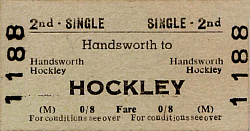 rebuilding of Snow Hill and the introduction of new diesel Pullman services all pointed towards the future being bright. On 1 January 1963 boundaries of BR regions were redrawn and Handsworth & Smethwick station came under the control of BR(LMR), and with the completion of the electrification programme and the linking of the main line from Paddington to Birmingham New Street the route north of Snow Hill was considered to be secondary. From the 14 June 1965 the LMR removed the ‘& Smethwick’ suffix from Handsworth – to avoid any confusion with the Stour Valley line Smethwick Rolfe Street - but signage was not replaced; instead, ‘& Smethwick’ was crudely painted out on the WR Totems, running-in-boards and the main station building sign. The penny-pinching ‘make-do-and-mend’ alteration was also carried out at several other former WR stations (e.g. Soho & Winson Green) which had recently been transferred to LMR administration and lost part of their name. This contradicted the official British Rail ‘Corporate Identity’ policy unveiled in early 1965 in which modern black and white signage would be fitted at stations to replace the former regional colours as part of the organisation’s attempt to project a progressive image. rebuilding of Snow Hill and the introduction of new diesel Pullman services all pointed towards the future being bright. On 1 January 1963 boundaries of BR regions were redrawn and Handsworth & Smethwick station came under the control of BR(LMR), and with the completion of the electrification programme and the linking of the main line from Paddington to Birmingham New Street the route north of Snow Hill was considered to be secondary. From the 14 June 1965 the LMR removed the ‘& Smethwick’ suffix from Handsworth – to avoid any confusion with the Stour Valley line Smethwick Rolfe Street - but signage was not replaced; instead, ‘& Smethwick’ was crudely painted out on the WR Totems, running-in-boards and the main station building sign. The penny-pinching ‘make-do-and-mend’ alteration was also carried out at several other former WR stations (e.g. Soho & Winson Green) which had recently been transferred to LMR administration and lost part of their name. This contradicted the official British Rail ‘Corporate Identity’ policy unveiled in early 1965 in which modern black and white signage would be fitted at stations to replace the former regional colours as part of the organisation’s attempt to project a progressive image.
In 1966 BR (LMR) issued a proposal to close the Birmingham Snow Hill to Wolverhampton Low Level route, and all stations, in its entirety. In 1966 there were 24 trains in each direction to and from Wolverhampton, with around 2,000 people per day travelling on them (figure includes Snow Hill to Langley Green shuttle). Objections were posted to the Transport Users’ Consultative Committee (TUCC) and the case for closure was discussed on 20 September 1966. The recommendation of the TUCC was the line was to remain open as closure would cause ‘extreme 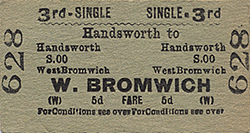 hardship’. This ruling caused the LMR to change tactics with the announcement that as of 4 March 1967 the main line trains along the whole route would be withdrawn and freight trains diverted along other routes. On 15 November 1967 the Minister of Transport, Barbara Castle responded to BR’s application, refusing to allow the closure of the Wolverhampton to Snow Hill and the branch to Langley Green, but allowing the closure of the southern section from Snow Hill towards Stratford and Leamington. With the lack of through freight and express passenger services the four-track section between Handsworth and Hockley could no longer be justified, so in August 1968 it was announced that the main lines would be closed and all remaining traffic concentrated on the relief lines. With the introduction of the May 1968 timetable the LMR further reduced the service level with Handsworth now seeing 35 down (Wolverhampton direction) services on Monday-to-Friday with 31 on Saturday, whilst the up workings consisted of 36 Monday-to-Friday trains, 34 on Saturday and the Sunday service was withdrawn. From May 1969 the service was reduced even further to just 10 down workings on Monday-to-Friday and seven on Saturday with 11 up (Birmingham direction) services Monday-to-Friday and nine on Saturday as the LMR attempted to undermine the line’s viability by running as few trains as possible: the station at Handsworth lost its complement of staff at the same time. Unlike many other stations along the route the platform buildings were retained following the withdrawal of station staff although the infrastructure slowly started to decay from a combination of vandalism, brought on by the absence of staff, and a general lack of maintenance; certainly not conducive to attract new, or even retain, passengers - but that was the intention. hardship’. This ruling caused the LMR to change tactics with the announcement that as of 4 March 1967 the main line trains along the whole route would be withdrawn and freight trains diverted along other routes. On 15 November 1967 the Minister of Transport, Barbara Castle responded to BR’s application, refusing to allow the closure of the Wolverhampton to Snow Hill and the branch to Langley Green, but allowing the closure of the southern section from Snow Hill towards Stratford and Leamington. With the lack of through freight and express passenger services the four-track section between Handsworth and Hockley could no longer be justified, so in August 1968 it was announced that the main lines would be closed and all remaining traffic concentrated on the relief lines. With the introduction of the May 1968 timetable the LMR further reduced the service level with Handsworth now seeing 35 down (Wolverhampton direction) services on Monday-to-Friday with 31 on Saturday, whilst the up workings consisted of 36 Monday-to-Friday trains, 34 on Saturday and the Sunday service was withdrawn. From May 1969 the service was reduced even further to just 10 down workings on Monday-to-Friday and seven on Saturday with 11 up (Birmingham direction) services Monday-to-Friday and nine on Saturday as the LMR attempted to undermine the line’s viability by running as few trains as possible: the station at Handsworth lost its complement of staff at the same time. Unlike many other stations along the route the platform buildings were retained following the withdrawal of station staff although the infrastructure slowly started to decay from a combination of vandalism, brought on by the absence of staff, and a general lack of maintenance; certainly not conducive to attract new, or even retain, passengers - but that was the intention.
Between May 1969 and March 1972 the service remained at a constant level of 10 down (Wolverhampton direction) services on Monday-to-Friday and seven on Saturday with 11 up workings on Monday-to-Friday and nine on Saturday. Passenger numbers had dwindled to one tenth of what they had been in 1966, and on 31 March 1971 the LMR made its move and posted closure notices for Wolverhampton Low Level to Birmingham Snow Hill, including the Langley Green shuttle; objections had to be received by 19 May 1971. The Transport Users’ Consultative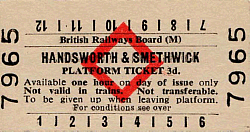 Committee received 199 objections in total and on 25 May, they, along with representatives from BR and WMPTE (the Executive body of the WMPTA), inspected the route and all the stations, travelling from Snow Hill by train to Wolverhampton; ironically they returned by bus! A Public Hearing was held at the Rainbow Suite in Birmingham on 14 July 1971 to listen to objections and decide the future of the line. The statement issued by the TUCC could not have been clearer: ‘The addition of displaced rail passengers at these times would aggravate an already critical situation and would result in hardship for all concerned’. Nevertheless, on 24 January 1972 the Minister granted permission for closure to be implemented with a date quickly set for 4 March. On the final day trains were expected to be heavily patronised, so, instead of being the usual single car DMU the trains were strengthened to three-car units with BR issuing souvenir tickets. The final Wolverhampton-bound train called at Handsworth at 5.57pm, the final Birmingham-bound service departed at 6.24pm being the 6.17pm from Langley Green. Committee received 199 objections in total and on 25 May, they, along with representatives from BR and WMPTE (the Executive body of the WMPTA), inspected the route and all the stations, travelling from Snow Hill by train to Wolverhampton; ironically they returned by bus! A Public Hearing was held at the Rainbow Suite in Birmingham on 14 July 1971 to listen to objections and decide the future of the line. The statement issued by the TUCC could not have been clearer: ‘The addition of displaced rail passengers at these times would aggravate an already critical situation and would result in hardship for all concerned’. Nevertheless, on 24 January 1972 the Minister granted permission for closure to be implemented with a date quickly set for 4 March. On the final day trains were expected to be heavily patronised, so, instead of being the usual single car DMU the trains were strengthened to three-car units with BR issuing souvenir tickets. The final Wolverhampton-bound train called at Handsworth at 5.57pm, the final Birmingham-bound service departed at 6.24pm being the 6.17pm from Langley Green.
The speed of the closure caught the timetable compilers unawares as the BR(LMR) publication of 1 May 1972 showed a phantom service of the familiar six Monday-to-Friday trains (seven on Saturday) in each direction between Birmingham Snow Hill and Wolverhampton Low Level, albeit with a warning that ‘the Department of the Environment has under consideration the withdrawal of this service … in the event of this taking place during the currency of the Timetable appropriate notice will be given’.
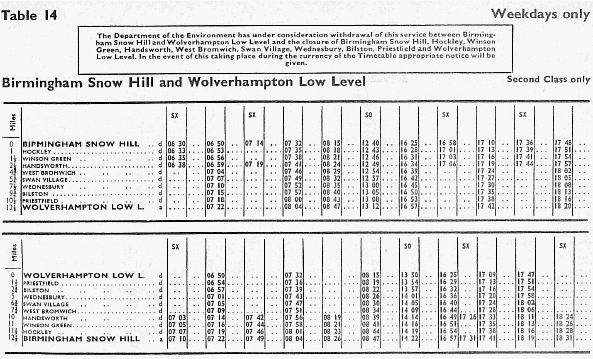
BR Timetable May 1972 - April 1973 showing the ghost service
It is thought that the main building at Handsworth station was demolished in 1971, prior to closure, as was the case at neighbouring Bilston and Wednesbury.
In late 1972 the main lines were removed but freight trains continued to use the relief lines to reach the Blue Circle Handsworth Cement Terminal (Queens Head Sidings). Some of the goods yard sidings were also retained to facilitate the shunting of scrap railway wagons and the resulting scrap metal trains into, and out of, the Coopers Metals private siding. The Handsworth & Smethwick South signal box was retained until closure on 21 December 1975; from that point onwards the relief lines were operated as two, independent, single lines. The up relief line was lifted in the 1980s leaving just the down relief in place. Trains continued to run to the cement terminal until 1992 when it was closed, although a scrap yard was established on the site and continues to despatch trains to this day. The connection for Coopers Metals still remains, although it appears to be out of use.
The West Midlands Passenger Transport Authority (WMPTA) had long recognised the importance of the Wolverhampton to Birmingham Snow Hill route, although it became responsible for rail services only in 1972 so nothing could be done to stop the initial closure. On 31 October 1973 the Authority and its Executive body took steps to protect the trackbed from any future development so that some kind of public transport system could be reintroduced. The Authority’s first success was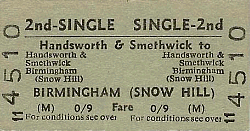 the rebuilding of Snow Hill, in the late 1980s, and the introduction of heavy rail services north of the station to Stourbridge and Kidderminster in 1995. With the first Metro proposal having to be abandoned owing to public opinion and construction difficulties, the route of the former relief lines from Snow Hill to Swan Village and onward using the trackbed of the former double-track main line to Wolverhampton was chosen. The WMPTA announced this on 16 February 1988 and on 16 November 1989 an Act of Parliament was granted for its construction. It was not until 3 August 1995 that the contract for construction was let to Altram, a consortium of Ansaldo and John Laing, with construction commencing on 13 November. The final section of track was laid on 4 February 1998 with public services beginning on 31 May 1999. the rebuilding of Snow Hill, in the late 1980s, and the introduction of heavy rail services north of the station to Stourbridge and Kidderminster in 1995. With the first Metro proposal having to be abandoned owing to public opinion and construction difficulties, the route of the former relief lines from Snow Hill to Swan Village and onward using the trackbed of the former double-track main line to Wolverhampton was chosen. The WMPTA announced this on 16 February 1988 and on 16 November 1989 an Act of Parliament was granted for its construction. It was not until 3 August 1995 that the contract for construction was let to Altram, a consortium of Ansaldo and John Laing, with construction commencing on 13 November. The final section of track was laid on 4 February 1998 with public services beginning on 31 May 1999.
The station’s platforms were extant in the early 1990s with the main line platforms especially overgrown; but there was one final ‘hurrah’ for the station on 21 October 1990. A charity walk from Snow Hill to Handsworth had been organised by CENTRO (the new name for the WMPTA) to allow members of the public, for a small donation, to walk the remains of the line prior to the re-laying of the relief lines and the re-introduction of Snow Hill to Stourbridge services. Track still ran through the down relief line platform face and a nine-car Class 116 DMU was provided to take the walkers to Birmingham New Street after a reversal at Smethwick West. The platforms were demolished shortly afterwards for construction of what came to be known as the ‘Jewellery Line’: sadly no station would be provided at Handsworth. The construction of the Metro, in the mid 1990s, did provide some positive news for the local residents as a tram stop was proposed, and constructed, on the site of the former main line platforms. A large flyover for the tramway was constructed so freight trains can still reach the Queens Head Sidings.
Today virtually all traces of the former GWR station have been swept away by the construction, of both, the Jewellery Line and the Midland Metro. The driveway leading from Booth Street still provides the only entrance to the tram stop. A section of wall, within the railway boundary, on the site of the former down relief platform also still stands; although it was difficult to ascertain if it was related to the station.
Tickets from Michael Stewart & Brian Halford, route map by Alan Young.
Sources:
- Bradshaw's Railway Guide December 1895 - Middleton Press
- Forgotten Railways: Volume 10, The West Midlands - Rex Christinsen - David & Charles Publishing 1985
- A Regional History of the Railways of Great Britain - Volume 7 The West Midlands - Rex Christiansen - David St John Thomas Publisher 1991
- A Century of Railways around Birmingham and the West Midlands Vol 1,2 & 3 - John Boynton - Mid England Books Publisher 1999
- From Main Line To Metro - John Boynton - Mid England Books 2001
-
Railway Passenger Station in Great Britain - A Chronology - Michael Quick - Railway & Canal Historical Society 2009
To see the
other stations on the Birmingham Snow Hill - Chester General line
click on the station name: Birmingham Snow Hill, Hockley, Winson Green,
The Hawthorns, West Bromwich, Swan Village,
Wednesbury, Bradley & Moxley, Bilston, Priestfield, Wolverhampton Low Level, Dunstall Park, Stafford Road, New Hadley Halt, Admaston Halt, Walcot,
Upton Magna, Abbey Foregate, Shrewsbury S&C,
Leaton, Oldwoods Halt, Baschurch, Stanwardine Halt, Haughton Halt,
Rednal & West Felton, Whittington Low Level, Weston Rhyn, Whitehurst Halt, Rhosymedre, Rhosymedre Halt, Wynville Halt, Rhos, Johnstown & Hafod, Rhosrobin Halt, Gresford, Rossett, Pulford, Balderton and Saltney
|

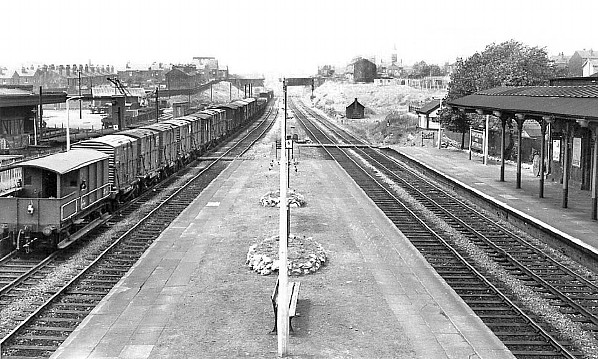
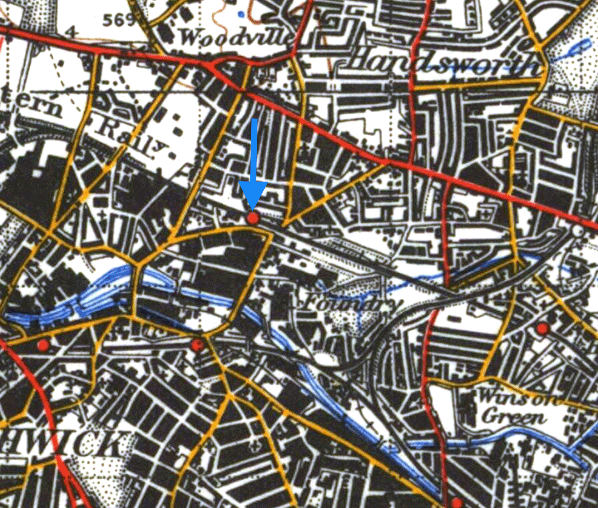
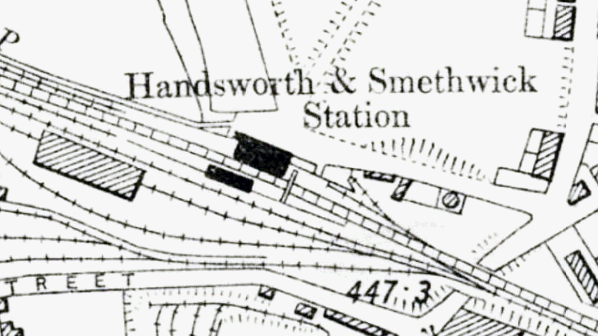
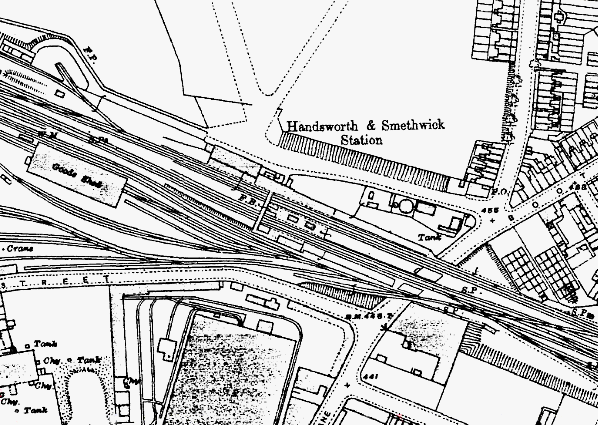
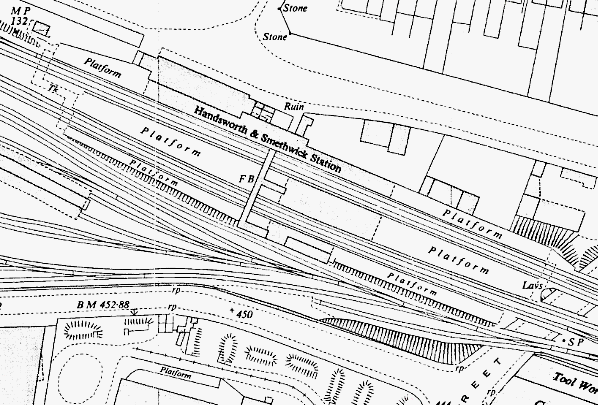
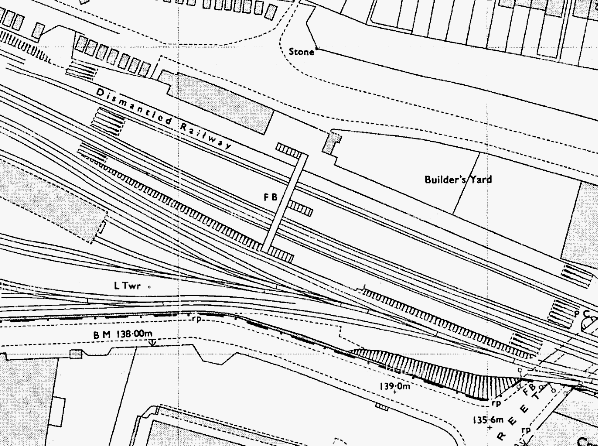
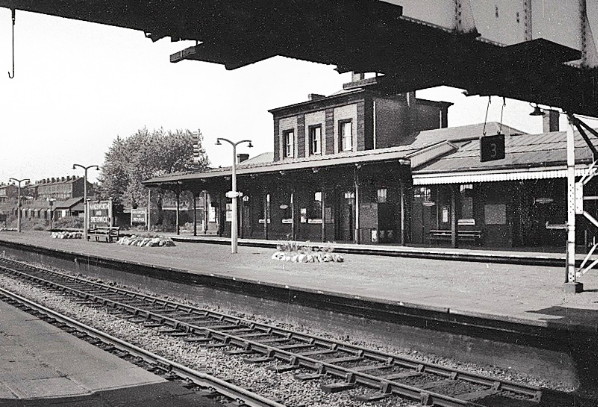


 rose above single-storey wings. The particular, somewhat dour, character of the building was given by the parapet (or blocking course) on the front and rear single-storey elevations and a cornice on the central section, almost concealing hipped roofs that lay behind them – a style associated with terraces with Classical pretensions in London, Bristol and Cheltenham. Although the overall construction was of brick, stone pilasters contributed gravitas to the upper storey of the central block, and stone was also employed in the cornices, parapets, quoins and the string course that surrounded the building. The openings on the upper floor and on the forecourt elevation of the wings were rectangular, with tablets below them bearing a simple geometric pattern; the central section of this elevation and all ground floor openings on the platform side were broad segmental arches apart from one centrally placed rectangular window. The arched openings were given stone quoins in a radial layout which added the only cheerful note to the otherwise sombre design. At the north-west end of the building was a short, single-storey extension with a lower roof-line than the adjoining wing repeating its style, even to the inclusion of a parapet. A ridged awning stretched along the platform elevation of the building.
rose above single-storey wings. The particular, somewhat dour, character of the building was given by the parapet (or blocking course) on the front and rear single-storey elevations and a cornice on the central section, almost concealing hipped roofs that lay behind them – a style associated with terraces with Classical pretensions in London, Bristol and Cheltenham. Although the overall construction was of brick, stone pilasters contributed gravitas to the upper storey of the central block, and stone was also employed in the cornices, parapets, quoins and the string course that surrounded the building. The openings on the upper floor and on the forecourt elevation of the wings were rectangular, with tablets below them bearing a simple geometric pattern; the central section of this elevation and all ground floor openings on the platform side were broad segmental arches apart from one centrally placed rectangular window. The arched openings were given stone quoins in a radial layout which added the only cheerful note to the otherwise sombre design. At the north-west end of the building was a short, single-storey extension with a lower roof-line than the adjoining wing repeating its style, even to the inclusion of a parapet. A ridged awning stretched along the platform elevation of the building. faces for the new relief lines. The original Birmingham platform remained although it was extended in the Birmingham direction up to Booth Street. A central island platform was created, on the site of the Wolverhampton platform with one face serving the down main whilst the other served the up relief line. A further platform was constructed, south-west of the island, to form the down relief platform. The sidings of the goods yard were slewed to the south to allow the platforms to be effectively shoehorned in without the company having to purchase any additional land, although the conversion from broad to standard gauge must have certainly helped with the project. A new covered footbridge was constructed to serve all three platforms. A barrow crossing, at the Wolverhampton end, was constructed to allow parcels and other such items to be transferred conveniently between the platforms. The four-track section opened on 19 December 1909.
faces for the new relief lines. The original Birmingham platform remained although it was extended in the Birmingham direction up to Booth Street. A central island platform was created, on the site of the Wolverhampton platform with one face serving the down main whilst the other served the up relief line. A further platform was constructed, south-west of the island, to form the down relief platform. The sidings of the goods yard were slewed to the south to allow the platforms to be effectively shoehorned in without the company having to purchase any additional land, although the conversion from broad to standard gauge must have certainly helped with the project. A new covered footbridge was constructed to serve all three platforms. A barrow crossing, at the Wolverhampton end, was constructed to allow parcels and other such items to be transferred conveniently between the platforms. The four-track section opened on 19 December 1909. 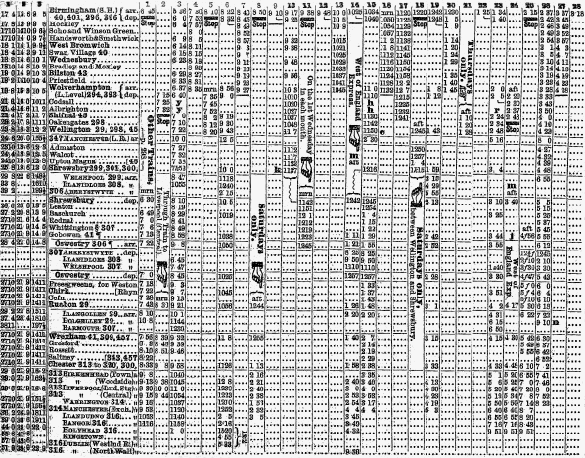
 rebuilding of Snow Hill and the introduction of new diesel Pullman services all pointed towards the future being bright. On 1 January 1963 boundaries of BR regions were redrawn and Handsworth & Smethwick station came under the control of BR(LMR), and with the completion of the electrification programme and the linking of the main line from Paddington to Birmingham New Street the route north of Snow Hill was considered to be secondary. From the 14 June 1965 the LMR removed the ‘& Smethwick’ suffix from Handsworth – to avoid any confusion with the Stour Valley line Smethwick Rolfe Street - but signage was not replaced; instead, ‘& Smethwick’ was crudely painted out on the WR Totems, running-in-boards and the main station building sign. The penny-pinching ‘make-do-and-mend’ alteration was also carried out at several other former WR stations (e.g. Soho & Winson Green) which had recently been transferred to LMR administration and lost part of their name. This contradicted the official British Rail ‘Corporate Identity’ policy unveiled in early 1965 in which modern black and white signage would be fitted at stations to replace the former regional colours as part of the organisation’s attempt to project a progressive image.
rebuilding of Snow Hill and the introduction of new diesel Pullman services all pointed towards the future being bright. On 1 January 1963 boundaries of BR regions were redrawn and Handsworth & Smethwick station came under the control of BR(LMR), and with the completion of the electrification programme and the linking of the main line from Paddington to Birmingham New Street the route north of Snow Hill was considered to be secondary. From the 14 June 1965 the LMR removed the ‘& Smethwick’ suffix from Handsworth – to avoid any confusion with the Stour Valley line Smethwick Rolfe Street - but signage was not replaced; instead, ‘& Smethwick’ was crudely painted out on the WR Totems, running-in-boards and the main station building sign. The penny-pinching ‘make-do-and-mend’ alteration was also carried out at several other former WR stations (e.g. Soho & Winson Green) which had recently been transferred to LMR administration and lost part of their name. This contradicted the official British Rail ‘Corporate Identity’ policy unveiled in early 1965 in which modern black and white signage would be fitted at stations to replace the former regional colours as part of the organisation’s attempt to project a progressive image. hardship’. This ruling caused the LMR to change tactics with the announcement that as of 4 March 1967 the main line trains along the whole route would be withdrawn and freight trains diverted along other routes. On 15 November 1967 the Minister of Transport, Barbara Castle responded to BR’s application, refusing to allow the closure of the Wolverhampton to Snow Hill and the branch to Langley Green, but allowing the closure of the southern section from Snow Hill towards Stratford and Leamington. With the lack of through freight and express passenger services the four-track section between Handsworth and Hockley could no longer be justified, so in August 1968 it was announced that the main lines would be closed and all remaining traffic concentrated on the relief lines. With the introduction of the May 1968 timetable the LMR further reduced the service level with Handsworth now seeing 35 down (Wolverhampton direction) services on Monday-to-Friday with 31 on Saturday, whilst the up workings consisted of 36 Monday-to-Friday trains, 34 on Saturday and the Sunday service was withdrawn. From May 1969 the service was reduced even further to just 10 down workings on Monday-to-Friday and seven on Saturday with 11 up (Birmingham direction) services Monday-to-Friday and nine on Saturday as the LMR attempted to undermine the line’s viability by running as few trains as possible: the station at Handsworth lost its complement of staff at the same time. Unlike many other stations along the route the platform buildings were retained following the withdrawal of station staff although the infrastructure slowly started to decay from a combination of vandalism, brought on by the absence of staff, and a general lack of maintenance; certainly not conducive to attract new, or even retain, passengers - but that was the intention.
hardship’. This ruling caused the LMR to change tactics with the announcement that as of 4 March 1967 the main line trains along the whole route would be withdrawn and freight trains diverted along other routes. On 15 November 1967 the Minister of Transport, Barbara Castle responded to BR’s application, refusing to allow the closure of the Wolverhampton to Snow Hill and the branch to Langley Green, but allowing the closure of the southern section from Snow Hill towards Stratford and Leamington. With the lack of through freight and express passenger services the four-track section between Handsworth and Hockley could no longer be justified, so in August 1968 it was announced that the main lines would be closed and all remaining traffic concentrated on the relief lines. With the introduction of the May 1968 timetable the LMR further reduced the service level with Handsworth now seeing 35 down (Wolverhampton direction) services on Monday-to-Friday with 31 on Saturday, whilst the up workings consisted of 36 Monday-to-Friday trains, 34 on Saturday and the Sunday service was withdrawn. From May 1969 the service was reduced even further to just 10 down workings on Monday-to-Friday and seven on Saturday with 11 up (Birmingham direction) services Monday-to-Friday and nine on Saturday as the LMR attempted to undermine the line’s viability by running as few trains as possible: the station at Handsworth lost its complement of staff at the same time. Unlike many other stations along the route the platform buildings were retained following the withdrawal of station staff although the infrastructure slowly started to decay from a combination of vandalism, brought on by the absence of staff, and a general lack of maintenance; certainly not conducive to attract new, or even retain, passengers - but that was the intention. Committee received 199 objections in total and on 25 May, they, along with representatives from BR and WMPTE (the Executive body of the WMPTA), inspected the route and all the stations, travelling from Snow Hill by train to Wolverhampton; ironically they returned by bus! A Public Hearing was held at the Rainbow Suite in Birmingham on 14 July 1971 to listen to objections and decide the future of the line. The statement issued by the TUCC could not have been clearer: ‘The addition of displaced rail passengers at these times would aggravate an already critical situation and would result in hardship for all concerned’. Nevertheless, on 24 January 1972 the Minister granted permission for closure to be implemented with a date quickly set for 4 March. On the final day trains were expected to be heavily patronised, so, instead of being the usual single car DMU the trains were strengthened to three-car units with BR issuing souvenir tickets. The final Wolverhampton-bound train called at Handsworth at 5.57pm, the final Birmingham-bound service departed at 6.24pm being the 6.17pm from Langley Green.
Committee received 199 objections in total and on 25 May, they, along with representatives from BR and WMPTE (the Executive body of the WMPTA), inspected the route and all the stations, travelling from Snow Hill by train to Wolverhampton; ironically they returned by bus! A Public Hearing was held at the Rainbow Suite in Birmingham on 14 July 1971 to listen to objections and decide the future of the line. The statement issued by the TUCC could not have been clearer: ‘The addition of displaced rail passengers at these times would aggravate an already critical situation and would result in hardship for all concerned’. Nevertheless, on 24 January 1972 the Minister granted permission for closure to be implemented with a date quickly set for 4 March. On the final day trains were expected to be heavily patronised, so, instead of being the usual single car DMU the trains were strengthened to three-car units with BR issuing souvenir tickets. The final Wolverhampton-bound train called at Handsworth at 5.57pm, the final Birmingham-bound service departed at 6.24pm being the 6.17pm from Langley Green. 
 the rebuilding of Snow Hill, in the late 1980s, and the introduction of heavy rail services north of the station to Stourbridge and Kidderminster in 1995. With the first Metro proposal having to be abandoned owing to public opinion and construction difficulties, the route of the former relief lines from Snow Hill to Swan Village and onward using the trackbed of the former double-track main line to Wolverhampton was chosen. The WMPTA announced this on 16 February 1988 and on 16 November 1989 an Act of Parliament was granted for its construction. It was not until 3 August 1995 that the contract for construction was let to Altram, a consortium of Ansaldo and John Laing, with construction commencing on 13 November. The final section of track was laid on 4 February 1998 with public services beginning on 31 May 1999.
the rebuilding of Snow Hill, in the late 1980s, and the introduction of heavy rail services north of the station to Stourbridge and Kidderminster in 1995. With the first Metro proposal having to be abandoned owing to public opinion and construction difficulties, the route of the former relief lines from Snow Hill to Swan Village and onward using the trackbed of the former double-track main line to Wolverhampton was chosen. The WMPTA announced this on 16 February 1988 and on 16 November 1989 an Act of Parliament was granted for its construction. It was not until 3 August 1995 that the contract for construction was let to Altram, a consortium of Ansaldo and John Laing, with construction commencing on 13 November. The final section of track was laid on 4 February 1998 with public services beginning on 31 May 1999.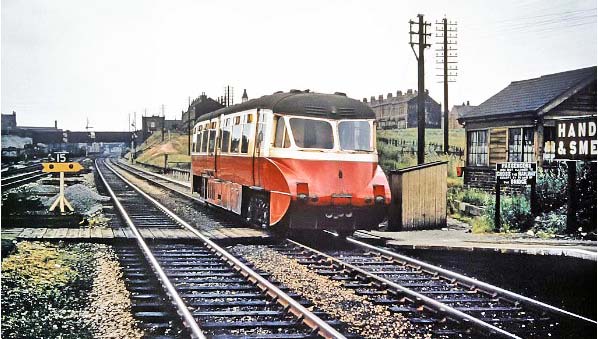
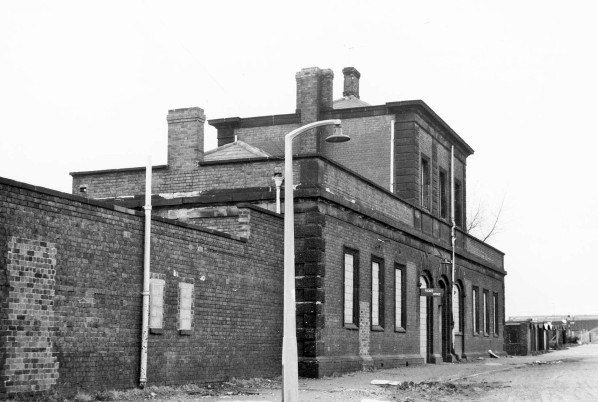
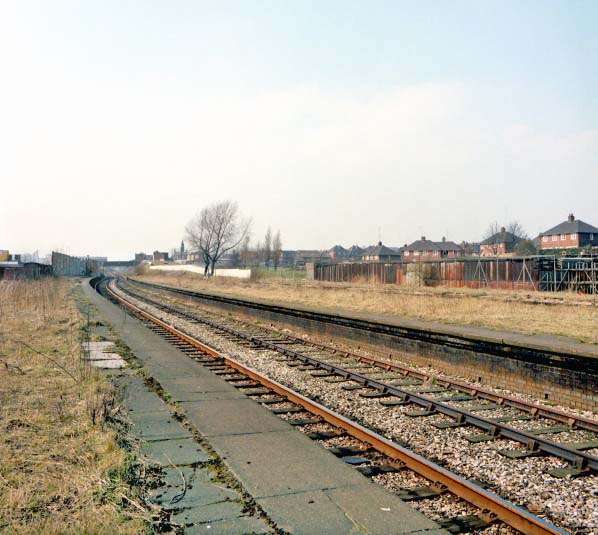
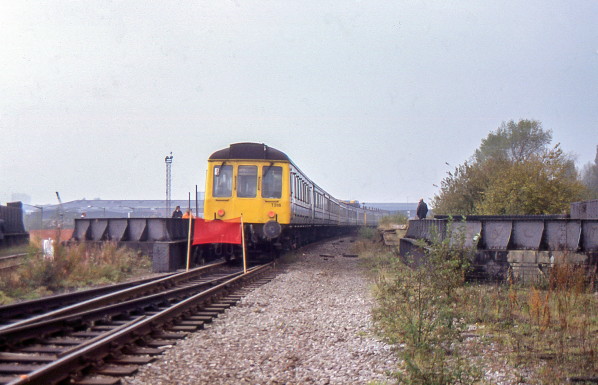 Remarkebly the station was used for a one-off passenger train on 21 October 1990 inconjunction with a Snow Hill to Handsworth charity walk organised by Centro. The lengthy 9-car Class 116 DMU would convey walkers back to Birmingham New Street station.
Remarkebly the station was used for a one-off passenger train on 21 October 1990 inconjunction with a Snow Hill to Handsworth charity walk organised by Centro. The lengthy 9-car Class 116 DMU would convey walkers back to Birmingham New Street station.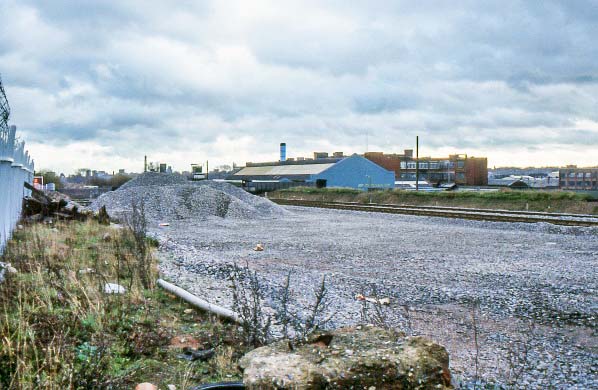
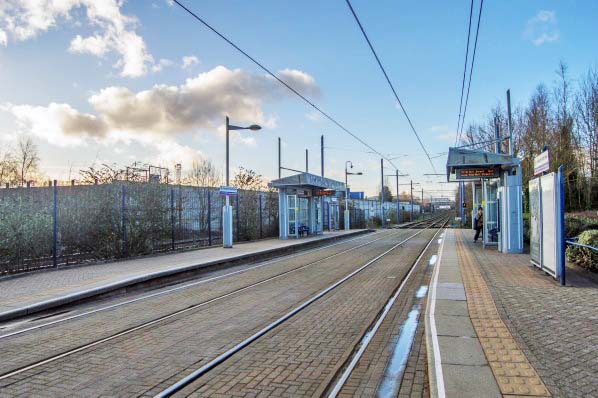

 Home Page
Home Page